| Mount Rainier, Washington 14,411 feet |
Climbed 8/17/1999 |
We climbed Mount Rainier, the highest point in Washington at 14,411 ft, in August 1999. Climbing Rainier is a serious undertaking involving roped travel over glacial terrain. Evelyn and I are not crazy or experienced enough to attempt this peak on our own; we went with a group from Rainier Mountaineering Institute (RMI). It's a three-day program. The first day is "snow school," where you learn the basics of glacial travel: dressing in layers, using an ice axe, self-arresting falls, traveling on a rope team, walking using the mountaineer's step, and breathing efficiently at high altitudes. The second day you hike up to the high camp at Camp Muir; the third day is the summit bid.
Snow school was something of a review session for Evelyn and I, since we had taken a more extensive winter mountaineering course a couple of years ago. The weather wasn't encouraging: the entire park was shrouded in fog with occasional drizzle. On our way to the snowfield where we had the class, we passed a number of places that looked like they were probably scenic viewpoints, but we couldn't see anything. I started to think we might well make the top but see nothing but the crater itself.
When we woke up the next morning, though, the sky was clear. In fact, it was downright summery. We could see the mountain from our hotel—heck, on a clear day you can see Rainier from anywhere in Washington. After we drove to the guide house for our equipment check, I changed into shorts and a T-shirt. The outfit matched the sunburns Evelyn and I had already gotten the day before: who remembers to put on sunscreen when you can't see the sun?
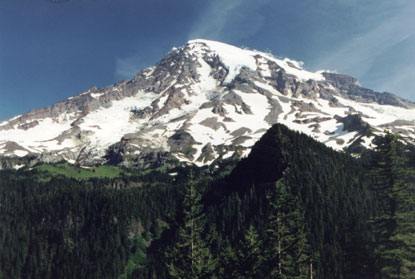
Mount Rainier
We left from the Paradise guide house at about 9:30, a group of 23 climbers and 6 guides walking single-file up the Skyline Trail. It wasn't long before we'd left behind the paved trails, green meadows, and noisy marmots for the steep Muir Snowfield. The fog started creeping in again as we climbed higher and higher, but it never approached the white-out conditions of the previous day. We could always see the Nisqaully Glacier above us to our left.
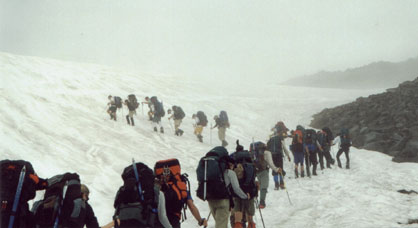
Up into the snow and clouds
We reached Camp Muir (10,080') by mid-afternoon. One of the benefits of climbing with RMI is that they have a cabin at Camp Muir. Perhaps "cabin" is too generous a word for the square wooden box they cram the 23 of us into, but I'm not complaining. It sure beats carrying and setting up tents.
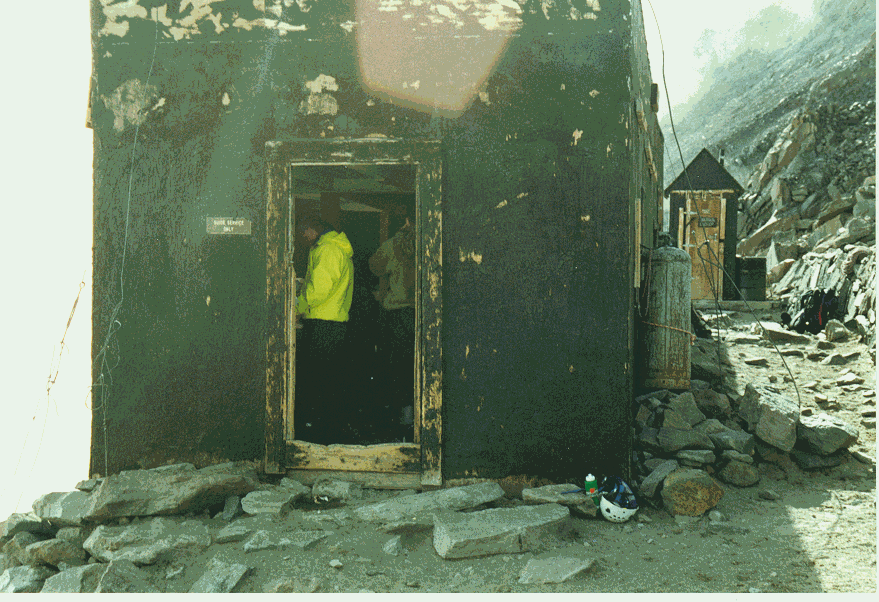
Luxury suite
As Evelyn and I settled in on the top bunk (at the top of the ladder in the picture below) with seven others, the lead guide explained the agenda for the rest of the climb. First we would meet with our newly assigned rope teams so that the team leader could check our glacier-climbing paraphernalia: harnesses, crampons, helmets, headlamps. Next the guides would bring in freshly boiled water so we could prepare dinner. After that, around 6:00 or so, we'd all retire to bed. Why to bed so early? Because we'd be getting up at midnight to start the ascent.
Evelyn and I were assigned to separate rope teams. My team consisted entirely of men, all except me and the guide over the age of 50. By what rationale was I assigned to this team? I don't know: maybe my tendency to set a slow steady pace? Evelyn was on a more diverse team, probably reflecting how fast she walks.
In the crowded confusion that surrounded dinner, I was one of three people who spilled their dinners all over the floor. Luckily we had also brought slices of cold pizza with us, and they tasted most excellent.
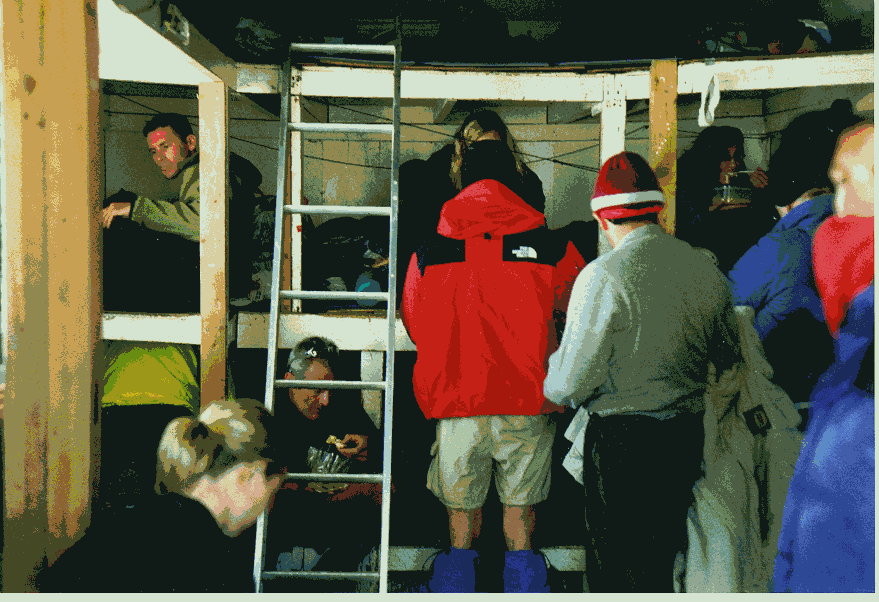
23 in the hut, 9 of us sharing the top bunk
As we got organized, the wind came up and blew most of the clouds away. The view from Camp Muir was fabulours.
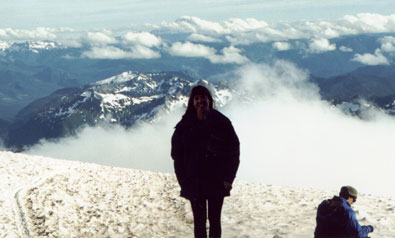
The view from Camp Muir
Mt Adams is the high point above the clouds in the distance.
As you might imagine, we didn't sleep very much. It was only 6:00, the wind was blowing outside, we were nervous about the upcoming climb, and there were 23 people in the cabin, fidgeting in their sleeping bags, farting, and taking turns heading for the outhouse. At best I fell asleep for a few minutes at a time.
I was actually asleep when our lead guide came to wake us. It being pitch dark outside, it wasn't very easy to eat breakfast, get our packs organized, put on our helmets and crampons, and report to our rope teams. In fact, I think Evelyn and I may have been the very last people ready.
If you, like me, are the kind of person who likes a map to provide some context for a narrative like this, click here for a picture of Mount Rainier's summit showing our route. We followed the Disappointment Cleaver route.
At around 1:30, we turned on our headlamps and headed out from camp, one rope team at a time. We had seen the first section of the route from camp before it got dark: a traverse across the snowfield at the top of the Cowlitz Glacier, then over the rocks of Cathedral Gap. It didn't take long to get the hang of walking on the rope team, pacing yourself so that the rope had just the right amount of slack both in front of you and behind you. Too much slack and the rope wouldn't do you any good if you (or a ropemate) fell; too little slack and the taut rope can pull you off balance.
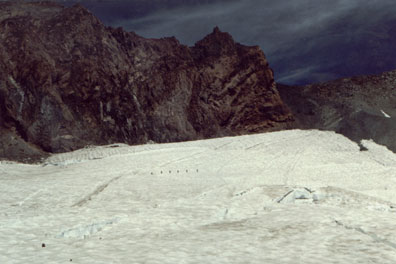
Crossing Cowlitz Glacier to Cathedral Gap (photo taken on descent)
Crossing over Cathedral Gap, there was a breeze blowing fine bits of rock dust into my eyes. I couldn't see it, but I could feel it, and boy was it annoying. Thankfully we reached the Ingraham Glacier on the other side relatively soon. Ingraham Flats was our first rest stop. We had been hiking for an hour and a half already, but it had gone by quickly. Three climbers had already decided they weren't going to make it, including one from my team. The guide leading my rope was chosen as the one to return to Camp Muir with them, so I was switched to another rope team.
The next section, our guides told us, was the crux of the climb: passing under in Ingraham Headwall icefall, then up the rocks of Disappointment Cleaver. The picture below shows some of the rope teams approaching the icefall. (Well, actually, it shows some rope teams coming back from the icefall, since it was pitch dark when we all approached it.)
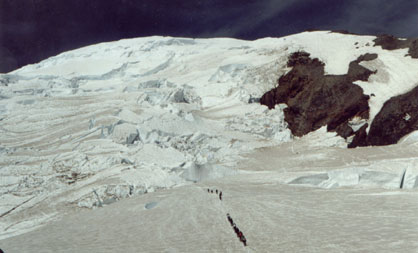
Ingraham Headwall icefall
We walked to the base of the icefall, then turned right and skirted its lower edge, stepping over crevasses and staying quiet to listen for falling ice.
Evelyn's team actually did encounter falling ice. They all heard a loud crack, then the sound of ice sliding over ice. They stopped dead in their tracks as their guide yelled, "Ice!" Headlamps were no use; they couldn't see anything. Their guide told them to turn their backs to the icefall as small flakes of ice hit their backs. Evelyn tensed her body in preparation for the big ice block to hit. Suddenly, the guide yells, "Okay, move!" The rope team hurried ahead to the safety of the rocks.
While Evelyn was weathering life-threatening situations, I was experiencing interpersonal drama on my new rope team. I was the first climber behind the guide, Kyle. As we passed below the icefall, the man behind me said, "Wait, hold on a second. My headlamp went out." Kyle yelled back, "Ron, I told you to change the batteries at the break!" I was caught between a bickering couple!
We weren't able to stop right away because we were right below the icefall. We had to clear the icefall and the first section of Disappointment Cleaver before we could safely take a break. Throughout this dangerous section, I was lurching forward and backward, being pulled in two directions. The rope behind me was pulling taut because Ron was going slowly, and the rope ahead was taut because Kyle wanted to keep us moving. Kyle would tell Ron to speed up, and Ron would reply that he couldn't see without his headlamp. Thankfully, Kyle had Ron and I swap positions on the rope when we finally stopped. Ron changed his batteries, Kyle gave a tirade about cheap headlamps with AA batteries in them, and I quietly prayed that the AA batteries in my headlamp would last until dawn.
Disappointment Cleaver is a steep rock formation. It would be a hard climb under the best of circumstances, but it was especially hard in the dark while wearing the sharp metal crampons on your boots. About halfway up we moved back onto the snow, climbing along the edge of the Cleaver.
On this steep snow slope, we encountered a traffic jam; that is, we got caught behind several rope teams backed up one after the other, including some teams not from the RMI group. Here we were at 5:00 in the morning, high on the side of a glacial mountain, and we had to slow down because there were too many people! For the rest of the climb, we occasionally had to slow down to wait for a group ahead of us.
Dawn broke as we reached the rest break at the top of Disappointment Cleaver. We switched off the headlamps and fished out our sunglasses. I got in trouble when I told Kyle that Evelyn had our one bottle of sunscreen—I was supposed to have my own.
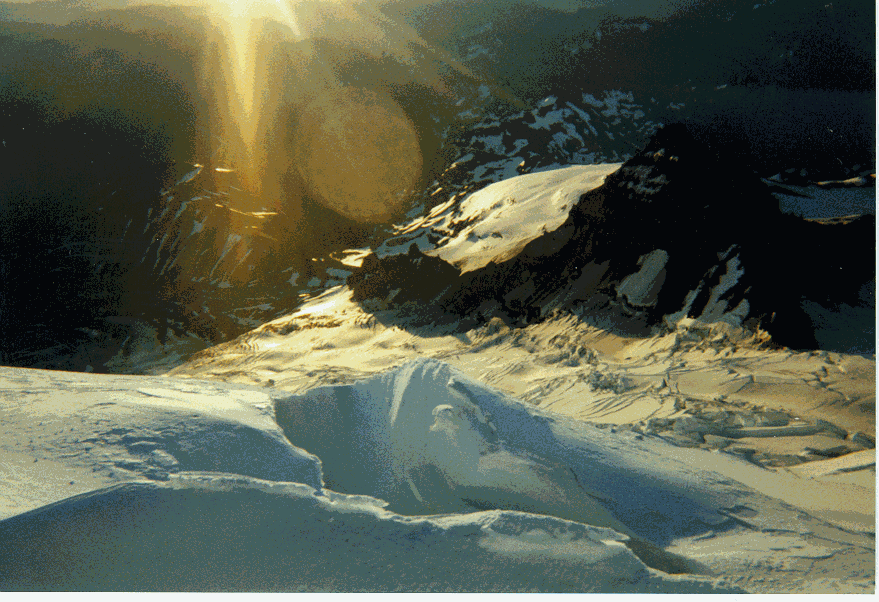
Dawn at the top of Disappointment Cleaver
This rest stop was the last chance for climbers to abandon the climb. At the urging of the guides, three more people decided to turn back, including Ron, who was having trouble with his back. Evelyn felt the sting of the sexism of mountain climbers: she was the only woman on her rope team, and her rope leader kept asking her if she was really sure she didn't want to turn back. He didn't ask any of the men on the team, just Evelyn, even though she was actually forcing the pace.
We soldiered on. From here, it was a clear shot to the summit, but the slope got steeper, crevasses became more common, and the altitude made breathing harder.
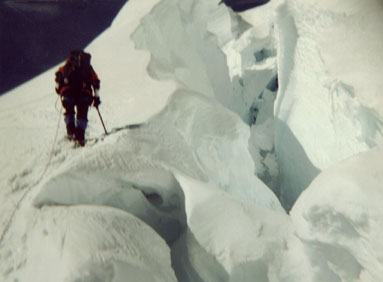 Crevasse
CrevasseWe trudged onwards and upwards for an hour and a half or so. We took our final break sitting unsheltered in the middle of a steep snow slope, on a tiny ledge quickly dug out by one of the guides. The drill at this break was the same as it was for all the others. We had fifteen minutes at most. In that time, we were supposed to get our parkas out of our packs, put them on, eat a snack, drink some water, reapply our sunscreen, drink some more water, listen to the guide's instructions, put everything back in the pack, and don't forget to breathe! Inevitably, Kyle would remind me to breathe right after I put a cheese cracker in my mouth, causing me to spray the snow with cracker crumbs. The only time I really felt the altitude was when I tried to eat and breathe at the same time.
From the last break, it was an hour to the summit. It was rather windy at this high, exposed elevation. The wind blew snow into our faces as we struggled up the final slope in another slow-moving traffic jam. As usual when you're approaching a summit, you keep looking up at what appears to be the top only to see it keep moving farther away.
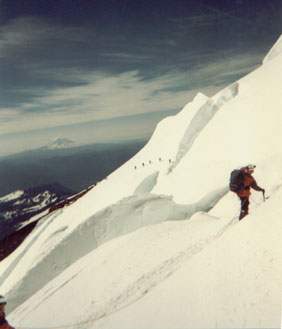
Roped together for safety, we navigate between the crevasses.
Mount Adams is in the distance.
Finally, I could see some climbers looking back towards us, smiling and whooping. The summit!
Mount Rainier's summit is a volcanic crater. Once we dropped inside the crater, its rim protected us from the wind. With the sun out and no clouds in sight, the weather couldn't have been better. We dropped our packs, untied from our ropes, and I went to find Evelyn. I have to say that everyone seemed a bit lethargic. We asked one of Evelyn's ropemates to take our picture, and he told me what an awesome woman Evelyn was. As if I didn't know. She was one of only three women in our group to make the summit.
The picture below shows Evelyn and I inside the summit crater, with the north rim in the background.
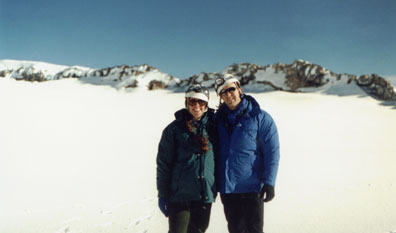
Whoopee! We made the summit!

Looking back at Mount Adams and Mount St. Helens
The climb down was in some ways more difficult than the climb up. First of all, the guides kept us moving quickly, maybe too quickly—on some of the switchbacks the rope went taut and nearly pulled me off my feet. Second, it was daylight now, so we could see how steep and dangerous everything looked. (We climbed up that?!) Third, we were exhausted. We reached the summit at about 8:45 AM (just over seven hours) and got back to Camp Muir around noon (12 hours after we woke up).
We spent an hour and a half at Camp Muir packing up the stuff we'd left behind. I decided that I didn't want to take my boots off until I could take them off for good, so despite the warm weather I didn't change out of my fleece pants. This turned out to be a tactical error, because we got very hot on the way back down to the trailhead. We didn't reach the car until 4:30, which was 14 hours after we'd started hiking that morning, and about 2 hours after Evelyn and I started getting on each other's nerves from the heat and exhaustion.
Click here to read Evelyn's view of the climb (some copied from Mike's story).